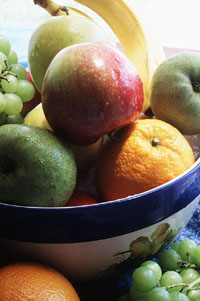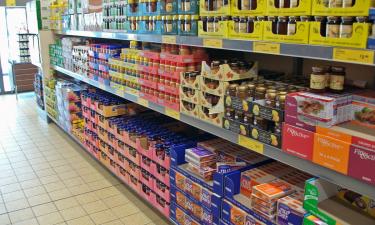Useful tips on choosing ripe fruit in grocery stores may help avoid ‘stomach anger’
Summer is coming and everybody knows that summer is the season of fruit. But unless you own an orchard or can buy fruit at a local farmers' market, "perfectly ripe fruit" is often not an option. In today's grocery stores, you're more likely to find fruit at the rock-hard stage, then you must ripen it at home. This is because the road from growers to American consumers is typically long (starting from as far away as New Zealand ), so growers must pick fruit while it's as hard as a cue ball. Only in such a state will fruit arrive at grocery stores relatively unblemished - and therefore appealing to shoppers.

Not all fruit ripens after harvest. It may become softer, juicier, or less acidic, but its starches stop converting into sugar after it has been picked, so it's important to select good quality at the store. Fruits that don't ripen further at home include berries, citrus fruit, grapes, and pineapples. They must be refrigerated or they will rot.
Of the fruits that do ripen at home, some reach their peak faster than others, provided they were picked after what growers call the "mature green" phase. Common ones include: bananas, pears, peaches, apricots, plums, and kiwi.
These fruits naturally emit ethylene gas, which accelerates the ripening process. Placing fruit in a paper bag and closing the top helps concentrate this gas, causing fruit to ripen faster. Bananas are particularly prolific ethylene producers, so if you enclose one in the bag with other ripening fruits, it will accelerate the process even more. Check them regularly, though, to catch them before they rot.
A room temperature of around 70 degrees F. is ideal for ripening. In warm temperatures, fruit ripens faster. In the refrigerator, fruit ripens very slowly.
After ripening, most fruits like it cold and humid. But they also need to breathe, so don't store them in a closed plastic bag. Open the supermarket plastic bag in which you bought the fruit before you place it in the refrigerator. Transfer fruits that need ripening into a paper bag, close the top, and let them sit at room temperature.
Here's how to know when fruit is ready:
1. Apples should be firm and crisp - not mealy. If you can dent them with your fingers, they'll make disappointing eating. They may be stored in the refrigerator for several weeks.
2. Bananas should be fully yellow without brown spots. They ripen fast, so buy them partly green. Contrary to popular belief (and despite the original "Chiquita Banana" jingle), you may refrigerate them after they've ripened. Their skin turns dark in the cold, but inside they are still good.
3. Berries, including strawberries, are high-moisture fruits with a very short storage life. Refrigerate after purchase. Make sure they don't sit in their own juice. Leaving them in a closed plastic bag is their death sentence. They're best kept in layers between paper towels, covered by a moist paper towel,orin an openpaper bag.Look for berries with a full, bright color. The smaller the size, the better the flavor.
4. Cantaloupe are usually sold quite firm. While some may be ripe, most have not yet reached their best stage. Ripen them for two to four days at room temperature. Avoid cantaloupe with softening over the rind.
5. Cherries should have lively green stems, a sign that they're still fresh. Cherries don't ripen off the tree, so refrigerate them and serve in a few days.
6. Grapes can be judged for freshness based on the condition of the stem. When the stems look like dried-up sticks, their harvest was in the distant past. Buy grapes that are firmly attached to nice green stems. Avoid soft or wrinkled grapes and those that are leaking (a sign of decay). They don't ripen after harvest, so refrigerate after purchase or serve soon.
7. Kiwis ripen well, but slowly, so buy them nearly a week before you use them. Buy them plump and firm but not rock hard. When kiwis yield to gentle pressure, they are ready. Once ripe, they spoil fast.
8. Oranges and other citrus fruits have great keeping qualities. Oranges are usually picked when ripe. Select fruit that is firm and evenly shaped. Skin color is not always a good guide to quality: Florida oranges can be slightly greenish; California oranges are usually a true orange. Small- to medium-size oranges tend to taste sweeter than larger ones. Keep citrus fruit chilled, and it will stay happy for weeks.
9. Peaches and nectarines ripen and spoil fast. Growers must ship them while they're hard. Make sure they have no soft brown spots, and ripen them for a few days. Once ripe, their shelf life is short, even when chilled. Buy in small quantities and eat quickly.
10. Pears should be purchased when they are firm, but they will ripen fast in your kitchen. When you feel a slight give as you gently squeeze them, they are ready to refrigerate or serve.
11. Pineapples don't ripen off the plant, so those picked green with little sugar development will remaintart and flavorless. Try to find pineapples that are bright yellow, not too hard, and have a sweet scent. Look for a plump, heavy fruit. Avoid ones that have a dull color, dry or brown leaves, or an overall dried appearance.
12. Plums can be delicious or bland, and a taste test is the best way to tell. Small plums tend to have better flavor. They have a short storage life, so buy them firm. They ripen in a few days in a paper bag on the kitchen counter.
13. Watermelons that produce a hollow sound when thumped are best. Turn the melon until you find a light spot where it sat on the ground. If yellow, the melon is ripe, if white, leave it behind. Once cut or ripened, watermelon should be refrigerated and eaten within a few days.
Source: The Christian Science Monitor
Prepared by Alexander Timoshik
Pravda.ru
Subscribe to Pravda.Ru Telegram channel, Facebook, RSS!





